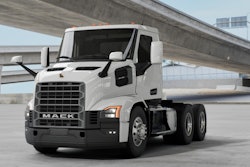Fleets and fleet maintenance can be costly.
Keeping track of these costs can be harrowing, especially the incidental ones. Costs associated with purchasing the vehicles will be pretty much fixed, although there may be some options to limit the short-term costs. Other expenses – maintenance, optimization, security and the like – can be much more fluid, but there are several ways to control them.
Retread tires instead of buying new ones
Tires can account for a significant portion of a fleet's costs. Instead of purchasing new tires when the old ones wear out, retread the radial-ply casings instead. When you retread, you'll increase the mileage until you need to buy a new set of tires by 120,000 miles, and the cost to retread a tire comes at just over one-third the price of purchasing a new one. Retreading is a great way to save money on tires without giving up the safety of your fleet.Install vehicle tracking systems to reduce mileage and gas consumption
While enforcing personal use of company vehicles may seem daunting, installing GPS on your fleet will make enforcement easier. Cut mileage on fleet vehicles by combining trips and improving the efficiency of multi-stop vehicles. Most GPS and Fleet Management software companies have a route optimization solution to improve drivers' routes, especially those with multiple stops.Good route optimization software will not only look for the shortest route but the quickest times, kind of like Google maps does (if you have those features turned on). This may include limiting left turns, avoiding high traffic areas and avoiding construction/accidents. Spending too many hours waiting in traffic wastes fuel over the years. This can save money on gallons of fuel across the fleet and reduce emissions.
Adding a GPS tracking system to each of your fleet vehicles will let you monitor whether your drivers speed on their routes, and controlling speed helps reduce vehicle fuel usage. For example, driving at 70 mph will use up to 15% more fuel than traveling at 50 mph. Speeding at 80 mph uses up to 25% more fuel than 70 mph. Vehicle tracking systems can send you a message when a driver speeds, so you can correct the action immediately via radio or phone.
Train drivers in fuel-efficient driving methods
One of the most critical and least expensive steps to rectify parts of your fleet’s fuel economy are your drivers. Train each driver in proper driving habits that help reduce fuel mileage. Discourage aggressive driving, such as rapid braking, fast acceleration, speeding, and hard turns. Studies have shown that aggressive driving habits reduce fuel efficiency by up to 40% depending on local versus highway traffic.When looking at fleet fuel consumption, these driving habits can equate to losing between 25-cents and $1 per gallon of fuel. If you multiply that across your fleet, you get an idea of the amount of money aggressive driving is wasting.
Use telematics
Initially, the expenditure in telematics to monitor your fleet may feel disconcerting, but in the longer term the data can help you in many ways. Real-time communication coupled with a routing app in your vehicle can increase the efficiency of your fleet.Also, using telematics can improve the safety of your vehicles and reduce operating costs while optimizing vehicle performance. Most Fleet Management software will include a set of telematics, so you may be able to bundle the costs.
Keep your fleet updated
It’s easy to become complacent when your fleet is stable and running smoothly. As a forward thinker, you need to stay ahead by timely updating your fleet.All vehicles have a finite lifespan to be the most fuel-efficient. If we consider your usage of those vehicles, you must update your fleet before the older ones cost more in fuel and repairs.
You may want to also look at leasing vehicles to lower your initial outlay of cash. Many companies will find a way to write off the lease expense for the term, and when the lease ends, buy at a lower cost and write off the depreciation. Your accounting team should be able to discern which way is best for you.
It will help you in the future and keep your workers satisfied with the best vehicles for their tasks.
Pay attention to warranties
This goes hand in hand with keeping your vehicles up to date. Usually, people won't look at the warranty until something goes wrong, but this may be too late if you haven't kept up with the requirements for the warranty to be valid (i.e., routine maintenance, length of the contract, etc.). This goes beyond just the vehicles but also the ancillary equipment such as GPS, cameras or any other add-ons.Get better insurance premiums
This one can be tricky because not all insurance companies have the exact requirements and discounts. Pooled insurances usually have better rates but do not give you as much coverage or discounts. With regular fleet insurance, you may be able to get discounts for having driver programs, for software that shows better driving habits, AI/Driver behavior cameras, video cameras protecting your vehicle, and fleet management software. You will need to see if going into a pooled resource will give you better rates, with comparable coverage as non-pooled insurance.Keep track of your KPIs
KPIs are performance measurements that demonstrate the effectiveness of your fleet management strategy. Successful fleet management KPIs guide you towards successful decisions to improve your fleet.The most common fleet management benchmarks are driver performance, operational efficiency and maintenance.
These three objectives can be used as a baseline to develop your organization's fleet management KPIs.
First, consider which area(s) of your fleet needs improvement. Perhaps you'd like to limit downtime or cut repair expenses. These goals can be a baseline for setting your KPI. Using historical data, you can then set fleet benchmarks to target.
While setting fleet management KPIs is one thing, meeting them is another. To meet fleet management KPI targets, you must effectively communicate strategies with your team and have complete access to real-time fleet data.
Staying connected and tracking every aspect of your fleet can be challenging, especially if you don't have a comprehensive tool to attain this. Many fleet managers are turning to software solutions to hit KPIs and get a complete, accurate view of fleet performance.
Leveraging fleet software allows you to seamlessly collaborate with your team and monitor fleet metrics in real-time. You can clearly track fleet management KPIs and set your fleet up for success by having maximum visibility into your assets.
Some of these suggestions (like Fleet Management Software) require up-front money, but will help you save money in the future. You may also want to think about taking one or two measures at a time to spread the implementation over multiple years. Not every fleet will be able to take advantage of all these suggestions based on size and need but keep them in mind when looking to lower your overhead.
Jayesh Mehta is the Director of Marketing at Fortress Mobile. He is also the author of “Rogue’s Guide to Acquisition: Principles from the Final Frontier” listed on Bill Gates Recommended Summer Reading of 2012. Jayesh has been in the marketing field since 2001 and with Fortress Mobile since 2020.












